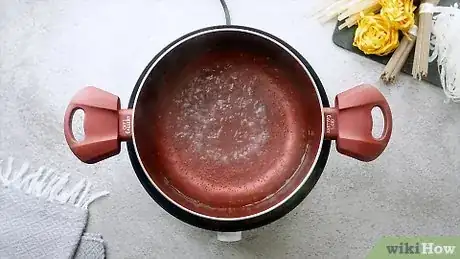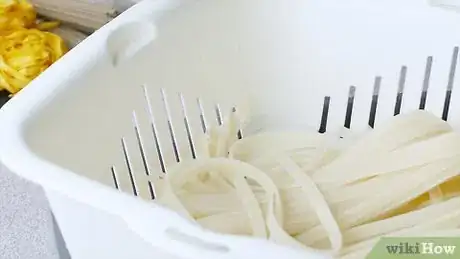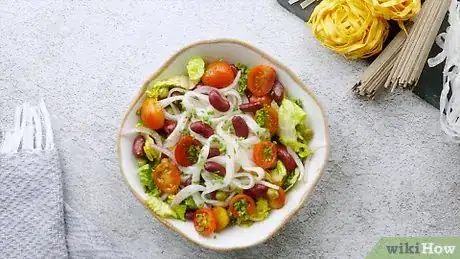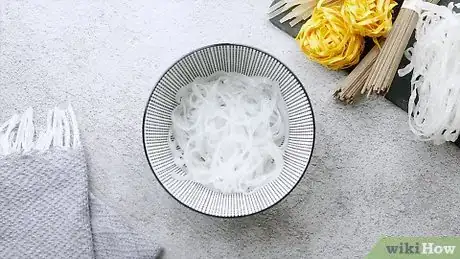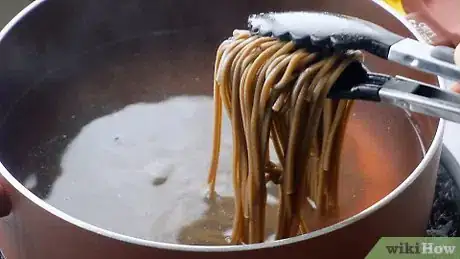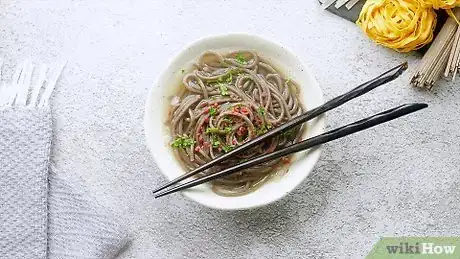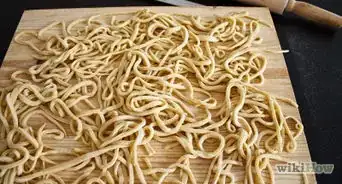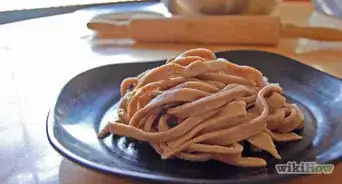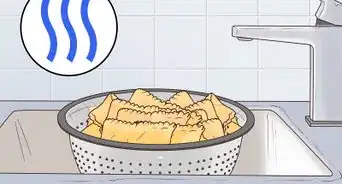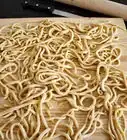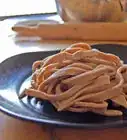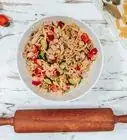This article was co-authored by Thuong Tan. Thuong Tan is a Noodle Expert and the Founder of Noodelist, a food startup producing plant-based instant noodles. Thuong holds a Bachelor’s degree in International Business and Marketing from Haaga-Helia, University of Applied Sciences, and an MBA in Luxury Brand Management from IFA Paris, Polimoda/Shanghai University. Noodelist’s mission is to produce premium plant-based moroheiya noodles that are nutrient-dense, texturally pleasing, and environmentally friendly.
This article has been viewed 564,596 times.
Noodles make a hearty, delicious side dish or main meal. You can whip them up in five minutes and enjoy with butter and cheese, or dress them up with a special sauce when you have guests over. They're wonderful in soups and casseroles, too. Different types of noodles require different cooking methods, but they're all equally easy to prepare. Read on to learn how to cook wheat or egg noodles, rice noodles, mung-bean noodles, or buckwheat (soba) noodles.
Steps
Cooking Wheat or Egg Noodles
-
1Bring a large pot of water to a boil. Fill up a big saucepan and place it on a burner over high heat.
-
2Drop a pinch of salt in the water. This helps flavor the noodles and helps the water boil at a higher temperature, reducing the cooking time.Advertisement
-
3Place the noodles in the boiling water. If you have long, thin noodles, like spaghetti, you might need to break them in half to fit them all in the pot.
- Don't add the noodles until the water has come to a rolling boil, or they'll end up getting soggy and mushy.
- Add the noodles gently so you don't splash hot water back onto your skin.
-
4Boil the noodles until tender. Depending on how thick the noodles are, you may need to boil them from anywhere from 5 minutes to 12. Read the instructions on your noodle package to determine the correct time.[1]
-
5Test to see whether the noodles are done. Pull out one noodle with a fork or slotted spoon. Taste the noodle. It should be soft enough to easily chew, but still have a bit of bite, meaning the noodle is 'al dente.' You can also try these other ways of testing whether the noodles are done:
- Toss a noodle against the wall. If the noodle sticks, it's ready.
- Look at the ends of the noodles. If they're white compared to the rest of the noodle, they need more time.
- Hold the noodles up with a fork. If they swing easily back and forth, they're done.
-
6Remove the noodles from heat and drain. Pour the noodles into a colander to drain the water away.
-
7Put the noodles in a bowl and add a few drops of olive oil. Stirring in just enough oil to finely coat the noodles keeps them from sticking together.
-
8Dress the noodles or use them in a recipe. Wheat and egg noodles are delicious with plain butter, olive oil, and salt and pepper. You can also use them as part of a casserole, add them to soups, or top with pasta sauce.
Cooking Rice Noodles
-
1Soak dried rice noodles in cold water for 30 minutes. This softens the noodles to prepare them for cooking.
- If you're using fresh, rather than dried, noodles, you can skip the soaking step.
-
2Drain the noodles.
-
3Bring a pot of water to boil.
-
4Add the noodles to the boiling water. The boiling time will vary according to the style of the rice noodle. They cook very quickly, and are ready when they're just soft.
- Rice stick-style noodles should boil for about 5 minutes.
- Vermicelli-style rice noodles will need to boil for only about 2 minutes.
-
5Drain the noodles. Pour them into a colander to drain the hot water.
-
6Serve the noodles. Use the noodles in salad or soup. Deep fried rice vermicelli is also a popular dish. These noodles can be shaped into a bird's nest presentation when freshly removed from hot oil.
Cooking Mung Bean Noodles
-
1Bring a pot of water to a boil.
-
2Remove the water from heat and let it cool slightly. Mung bean noodles shouldn't be boiled; they need only to soak in hot water.
-
3Add the noodles to the hot water. Leave them for about 15-20 minutes, until they become soft.
-
4Drain the water. Pour the noodles into a colander to let the hot water drain.
-
5Add the noodles to a dish. These noodles can be added to soups, stews and stir-fries.[2]
Cooking Buckwheat (Soba) Noodles
-
1Bring a large pot of water to the boil. Add a pinch of salt to the water.
-
2Drop the noodles into the boiling water.
-
3Wait for the water to return to a boil.
-
4Add 1 cup of cold water to the pot. This prevents the noodles from overcooking.
-
5Cook the noodles until they turn tender. It should take 5 - 7 minutes. The noodles should still taste a little chewy when they're finished. Be careful not to cook the noodles too long, as they become mushy very quickly.
-
6Drain the noodles.
-
7Rinse them briefly under cool water to stop the cooking process.
-
8Serve the noodles hot or cold. During the summer, the Japanese like to eat soba noodles in a cold broth; during the winter, warm broth is often used. They're delicious with a light dressing and grilled vegetables or fish.
Expert Q&A
-
QuestionHow long do you boil noodles for?
 Thuong TanThuong Tan is a Noodle Expert and the Founder of Noodelist, a food startup producing plant-based instant noodles. Thuong holds a Bachelor’s degree in International Business and Marketing from Haaga-Helia, University of Applied Sciences, and an MBA in Luxury Brand Management from IFA Paris, Polimoda/Shanghai University. Noodelist’s mission is to produce premium plant-based moroheiya noodles that are nutrient-dense, texturally pleasing, and environmentally friendly.
Thuong TanThuong Tan is a Noodle Expert and the Founder of Noodelist, a food startup producing plant-based instant noodles. Thuong holds a Bachelor’s degree in International Business and Marketing from Haaga-Helia, University of Applied Sciences, and an MBA in Luxury Brand Management from IFA Paris, Polimoda/Shanghai University. Noodelist’s mission is to produce premium plant-based moroheiya noodles that are nutrient-dense, texturally pleasing, and environmentally friendly.
Noodle Expert It totally depends on the type of noodle you're making and how hot the water is. You can generally tell by the texture of the noodles. Some people use the "does it stick to a wall" trick. You can always just taste a single noodle, too.
It totally depends on the type of noodle you're making and how hot the water is. You can generally tell by the texture of the noodles. Some people use the "does it stick to a wall" trick. You can always just taste a single noodle, too. -
QuestionWhat can I top fresh noodles with?
 Thuong TanThuong Tan is a Noodle Expert and the Founder of Noodelist, a food startup producing plant-based instant noodles. Thuong holds a Bachelor’s degree in International Business and Marketing from Haaga-Helia, University of Applied Sciences, and an MBA in Luxury Brand Management from IFA Paris, Polimoda/Shanghai University. Noodelist’s mission is to produce premium plant-based moroheiya noodles that are nutrient-dense, texturally pleasing, and environmentally friendly.
Thuong TanThuong Tan is a Noodle Expert and the Founder of Noodelist, a food startup producing plant-based instant noodles. Thuong holds a Bachelor’s degree in International Business and Marketing from Haaga-Helia, University of Applied Sciences, and an MBA in Luxury Brand Management from IFA Paris, Polimoda/Shanghai University. Noodelist’s mission is to produce premium plant-based moroheiya noodles that are nutrient-dense, texturally pleasing, and environmentally friendly.
Noodle Expert The possibilities are basically endless. Any kind of protein can work. You can also just top with fresh herbs and spices for a simpler dish. Beansprouts, mint leaf, and coriander, are personal favorites of mine, but feel to be creative!
The possibilities are basically endless. Any kind of protein can work. You can also just top with fresh herbs and spices for a simpler dish. Beansprouts, mint leaf, and coriander, are personal favorites of mine, but feel to be creative! -
QuestionIf I am adding noodles to a soup, is there any way to keep them from becoming mushy the next day?
 Community AnswerNoodles generally keep cooking as long as they are hot. To prevent noodles from going soft, they should be cooled as soon as they are done cooking. You should also wait until the soup is done cooking before adding the noodles. Keep in mind that noodles containing egg will probably hold their shape better than those without.
Community AnswerNoodles generally keep cooking as long as they are hot. To prevent noodles from going soft, they should be cooled as soon as they are done cooking. You should also wait until the soup is done cooking before adding the noodles. Keep in mind that noodles containing egg will probably hold their shape better than those without.
Things You'll Need
- Cooking pot (usually deep)
- Colander
References
About This Article
To cook noodles, start by bringing a pot of water to a boil and adding a pinch of salt, which will give the noodles some extra flavor. Then, carefully add the noodles to the boiling water. If the noodles are too long to fit in the pot, just break them in half before putting them in. Let the noodles cook until they're tender, which usually takes around 5-12 minutes. When they're finished cooking, drain them in a colander and serve. To learn how to cook rice noodles, scroll down!
